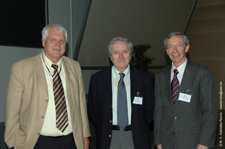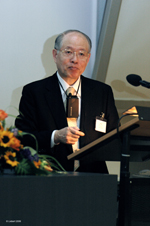|
|
Vol.
29 No. 3
May-June 2007
Green
Chemistry
by Fabio Aricò
Dresden, an integral part of the River Elbe valley, is surely
one of the most spectacular cities in eastern Germany. Its
architecture and historical monuments offer a great variety
of attractions to the almost 10 million tourists that visit
annually. Dresden is also one of the greenest cities in Europe.
Due to its magnificent landscapes and to far-sighted urban
planning, 63 percent of the city is devoted to woods and green
spaces. Thus, it should not be a surprise that this fantastic
location was selected for the First
International IUPAC Conference on Green-Sustainable Chemistry,
held 10–15 September 2006.
The conference, initiated upon the launching of the IUPAC
Green Chemistry Subcommittee, was conceptualized and planned
by Consorzio Interuniversitario Nazionale “La Chimica
per L’ambiente” (INCA) with the collaboration
of the German Chemical Society. It was sponsored by the Deutsche
Bundesstifung Umwelt and Bundesministerium fur Umwelt, Naturshutz
und Reaktorsicherheit and was organized under the auspices
of IUPAC, the Italian Ministry of Research, and the German
Federal Ministry of Environment, Nature Conservation and Nuclear
Safety. Logistical aspects of the conference were planned
by Wladimir Reschetilowski.
 |
| Wolfgang
Höelderich (left), Pietro Tundo, and David StC. Black. |
The
conference kicked off with remarks by Pietro Tundo (president
of INCA), Wolfgang F. Hoelderich (RWTH Aachen), and David
StC. Black (secretary general of IUPAC). This was followed
by the lecture of Frank Ruff, who gave his outlook on “Social
Change and Innovation in the 21st Century.”
The week-long conference was divided into five topics:
I. Benign Synthesis Routes: heterogeneous catalysis, homogeneous
catalysis, enzymatic catalysis, alternative solvents, new
reagents, “end of pipe” technology
II. Future Green Energy Sources: hydrogen technology, fuel
cell technology, biodiesel, energy saving
III. Use of Renewables: starch, cellulose, sugar, new detergents,
biomass technology
IV.
Benign Process Technology: micro-reactor technique, microwave
technology, photo chemistry, new regulation devices
V.
Education in Green Chemistry
The
wide selection of topics was intended to attract industrial
researchers and representatives, university educators and
researchers, as well as politicians and students interested
in green and sustainable chemistry. The enormous efforts of
the organizing committee paid off, as 450 people from 42 countries
attended the conference.
Each subtopic of the conference was presented by a keynote
lecture delivered by an international expert in that field.
Each day was divided into two parallel sessions, so that the
overall number of presented lectures was almost 120.
The program also included two plenary lectures. The first,
given by Jean-Marc Ané, of the Association Euratom-CEA,
on “Will Fusion Ever Be a Safe, Clean and Sustainable
Energy Source?” focused on the use of nuclear energy
as a possible, future green energy source. The European Union
is consuming more and more energy and importing more and more
energy products since its energy production is insufficient
to meet requirements. Ané showed that one of the most
promising energy sources is nuclear power. Euraton, as part
of its research on nuclear energy, is currently investigating
the fusion of lithium with tritium to obtain two helium molecule
(ITER Project). The energy derived from this process can be
collected. The main advantage of this process is that it produces
much less radioactive waste since no radio isotopic atoms
are involved in the process. Ané believes that the
European Union must maintain a leading position in the field
of civil nuclear technology in order to retain the necessary
expertise and develop more efficient fission reactors and
enable fusion to become a reality.
 |
| Ryoji
Noyori, Nobel Prize laureate for chemistry, 2001. |
Ryoji
Noyori, Nobel laureate in chemistry, delivered a fascinating
plenary lecture titled “Pursuing Practical Elegance
in Chemical Synthesis.” Noyori discussed how the concept
of Green Chemistry should not be seen as a matter of clear-cut
scientific or technical expertise, but rather as a serious,
complex social issue. In fact, he explained that the current
standards of chemical synthesis need to be much improved.
Many existing chemical processes, though beneficial, produce
unwanted wastes along with the target products. He noted that
the inefficient recovery of solvents is also an environmental
problem. Noyori pointed out that every reaction should proceed
with a high atom-efficiency, and the overall synthesis must
be accomplished with a low E-factor, thereby minimizing the
cost of waste disposal. Without such approaches, chemical
manufacturing is unsustainable. Researchers must influence
public opinion, Noyori said, in order to change government
policies in favor of creating sustainable societies. On the
scientific side, he noted, molecular catalysis plays a key
role in achieving this goal. Noyori presented some enlightening
examples of hydrogenation reactions that are ideal processes
for Green Chemistry.
The conference also included two poster sessions in which
the students discussed their latest results and achievements.
More than 280 posters were presented, making it very difficult
for the judging committee to chose the poster prize winners.
Finally, two students were selected for the genuine interest
they showed in their research, Maiko Kaneko, from the Japan
Advanced Institute of Sciences and Technology, and Falsig
Hanne from the Technical University of Denmark, Centre for
Sustainable and Green Chemistry.
 |
Group
photo of participants in the 1st International IUPAC Conference
on Green-Sustainable Chemistry.
>
view
jpg |
On
the final day of the conference Tundo and Hoelderich remarked
that the event had exceeded the expectations of the organizing
committee. They also stressed that this big event should be
considered an important starting point for collaboration between
IUPAC and the Green Chemistry community. They concluded by
inviting everyone to the second International IUPAC Conference
on Green Chemistry, which will be held in September 2008 on
a boat traveling from Moscow to St. Petersburg.
Fabio
Aricò <[email protected]>
works with Pietro Tundo in Venezia (Italy) where he is involved
in a joint project between INCA and Imperial Chemical Industries
PLC.
Page
last modified 11 June 2007.
Copyright © 2003-2007 International Union of Pure and
Applied Chemistry.
Questions regarding the website, please contact [email protected]
|